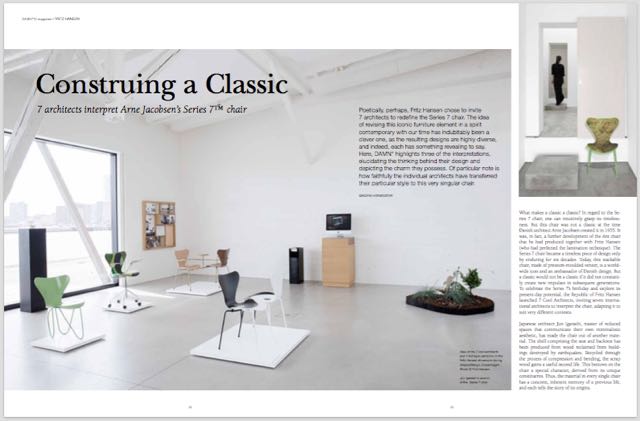7 architects interpret Arne Jacobsen's Series 7 chair
What makes a classic a classic? In regard to the Series 7 chair, one can intuitively grasp its timelessness. But this chair was not a classic at the time Danish architect Arne Jacobsen created it in 1955. It was, in fact, a further development of the Ant chair that he had produced together with Fritz Hansen (who had perfected the lamination technique). The Series 7 chair became a timeless piece of design only by enduring for six decades. Today, this stackable chair, made of pressure-moulded veneer, is a worldwide icon and an ambassador of Danish design. But a classic would not be a classic if it did not constantly create new impulses in subsequent generations. To celebrate the Series 7’s birthday and explore its present-day potential, the Republic of Fritz Hansen launched 7 Cool Architects, inviting seven international architects to interpret the chair, adapting it to suit very different contexts.
Japanese architect Jun Igarashi, master of reduced spaces that communicate their own minimalistic aesthetic, has made the chair out of another material. The shell comprising the seat and backrest has been produced from wood reclaimed from buildings destroyed by earthquakes. Recycled through the process of compression and bending, the scrap wood gains a useful second life. This bestows on the chair a special character, derived from its unique constituents. Thus, the material in every single chair has a concrete, inherent memory of a previous life, and each tells the story of its origins.
Norwegian Architects Snøhetta approached the task from another angle: “How can a design project be a remedy for human interaction and social innova- tion?” asked the Oslo-based team, choosing to interpret the Series 7 chair in an experimental way. They focused on the social function of the furniture piece and simply removed the shell from its legs, separating the metal from the wood. Consequently, the ‘soft’ part of the chair could be used outdoors. By balancing oneself in the right way, the reduced chair perfectly serves as an ad hoc seat on public terraces, for example. Suddenly the social qualities of the shell are rediscovered. And the chair’s supporting frame can be worn like a backpack.
Pritzker prize-winning architect Zaha Hadid is known for her dynamic aesthetics. Hadid’s buildings draw lines and curves in space – the new design for the Series 7 does the same. Instead of working on the shell, the base was the design team’s main chal- lenge. “We wanted to create a base that cradles the shell in such a way that base and shell are elegantly interrelated”, they explain. The formal language of the shell, its fluid form, therefore dictated the parameters for the structure. Two continuous steel rods form a lightweight, sculptural structure that touches the ground with no apparent effort. From there, the thin metal curves reach up to embrace the undulating shape of the seat’s shell.
The four other architects who have made design proposals are Jean Nouvel, BIG, Neri & Hu, and Carlos Ott & Carlo Ponce de Leo?n, offering yet more takes on the Series 7. This chair seems to have set free many and various ideas, bringing surprising inspiration to some of the substantial issues of our current time. The ability to influence contemporary design issues and unleash creative potential is rooted in Jacobsen’s philosophy. “As thin as possible and never in the middle”, was one of the many humorous instructions the master imparted on his students and staff members con- cerning daily work. Arne Jacobsen was a perfectionist, with a cheerful attitude towards design issues and towards life.
Text: Sandra Hofmeister

